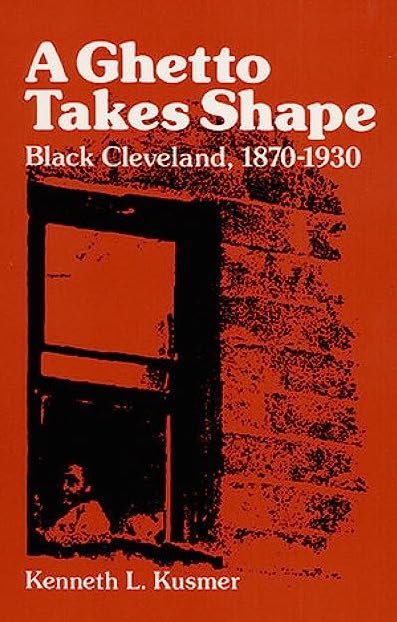A Ghetto Takes Shape
Black Cleveland, 1870-1930
By Kenneth L. Kusmer
In the Greater Cleveland region, it seems that the racial landscape is so entrenched that it might be hard to imagine the community looking much different than it has over the last 40+ years. Cleveland regularly ranks near the top of U.S. large cities most racially segregated, and if people have spent much time in the area – it’s likely their lived experience bears out Cleveland’s place in those rankings.
And yet, as Kenneth Kusmer’s seminal work, A Ghetto Takes Shape (1976) indicates, Cleveland did not always look like this. In fact, in a state that was generally hostile to Black Americans (an 1807 Ohio law required that two people would be necessary to guarantee a “surety” of $500 for Black residents’ good behavior), the Cleveland area emerged in the 19th century as a region that was relatively welcoming. As Kusmer refers to it – Black residents were “almost equal” to whites before 1870. Before the Civil War, the region was active in the Underground Railroad. What was once called East Cleveland Township – now University Circle – was a hotbed of abolitionist sentiment filled with activists, such as the Cozad and Ford families. St. John’s church in Ohio City was an integral last stop before a freedom seeker could get on a ship and make the last part of the journey to Canada. Although few in number, Black Clevelanders in the 19th century lived interspersed among European immigrants or other groups.
As the 19th century gave way to the 20th century, racial segregation in Cleveland began to take a shape that hardened, and frankly explains how our hypersegregated community came to be. Kusmer’s book traces with incredible detail the forces that pushed elements of the tenuous racial “equality” into widespread discrimination, occupational decline and Black attempts to fight the direction of policies limiting virtually every aspect of their lives. The book highlights many prominent Black leaders such as George Myers and Charles Chesnutt, who disagreed over ways to fight back (integration vs. creation of Black institutions).
The origins of the Black ghetto in Cleveland took place in the midst of massive European immigration to the area coupled with the emergence and growing popularity of eugenics – what we know today was a false “race science” that purported to prove the inferiority of non-European races and thus justify limited opportunities for them. The Great Migration brought thousands of Black families to Cleveland, and most settled in the area west of East 55th street between Euclid Avenue and the river because of policies that limited where Black families were shown homes. Over time, Central Avenue became the central artery of the Black ghetto.
Kusmer’s work tells stories of Black leaders and their interactions with whites who dominated most positions of power in business and politics. He highlights the fact, for instance, that the Cleveland police largely agree not to enforce laws in the emerging ghetto, probably as an agreement with Thomas Fleming, the city’s first Black city councilman, and his close associate, Albert “Starlight” Boyd, whose many businesses were involved in illegal activities. Black space became associated with illegal activities as a result.
Kusmer’s meticulous book, which has been around for decades, has so much more information for those who want to understand how Cleveland’s racial landscape emerged. Near the end, he concludes that the creation of the ghetto over the course of 50 years would ultimately leave the “average Black citizen more isolated from the general life of the urban community” than it had ever been. And yet – our city’s early history would not have been able to foretell what would emerge.
And today, we are left to address that which we inherited – certainly a difficult, yet essential, task.
